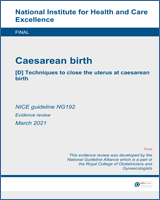From: Techniques to close the uterus at caesarean birth

NCBI Bookshelf. A service of the National Library of Medicine, National Institutes of Health.
| Quality assessment | Number of women | Effect | Quality | Importance | ||||||||
|---|---|---|---|---|---|---|---|---|---|---|---|---|
| Number of studies | Design | Risk of bias | Inconsistency | Indirectness | Imprecision | Other considerations | Single-layer uterine closure (intervention) | Double-layer uterine closure (control) | Relative (95% CI) | Absolute | ||
| Blood transfusion | ||||||||||||
| 3 (Chitra 2004, Nabhan 2008, Poonam 2006) | Randomised trials | Very serious1 | No serious inconsistency | Very serious2 | No serious imprecision | None |
3/662 (0.45%) |
20/662 (3%) | RR 0.19 (0.07 to 0.55) | 24 fewer per 1000 (from 14 fewer to 28 fewer) | VERY LOW | CRITICAL |
| Antibiotics required (unspecified reason) | ||||||||||||
| 2 (Darj 1999, Xavier 2005) | Randomised trials | Very serious1 | No serious inconsistency | Very serious2 | No serious imprecision | None |
73/102 (71.6%) |
64/94 (68.1%) | RR 1.02 (0.94 to 1.11) | 14 more per 1000 (from 41 fewer to 75 more) | VERY LOW | IMPORTANT |
| Antibiotics for wound infection (and wound sepsis) (pooled all CS) | ||||||||||||
| 3 (Nabhan 2008, Poonam 2006, Ohel 1996) | Randomised trials | Very serious3 | Serious4 | Very serious2 | Very serious5 | None |
15/662 (2.3%) |
23/662 (3.5%) | RR 0.77 (0.27 to 2.24) | 8 fewer per 1000 (from 25 fewer to 43 more) | VERY LOW | IMPORTANT |
| Antibiotics for wound infection (and wound sepsis) (Subgroup analysis, first CS only) | ||||||||||||
| 2 (Nabhan 2008, Poonam 2006) | Randomised trials | Very serious6 | Very serious7 | Very serious2 | Very serious5 | None |
7/500 (1.4%) |
16/500 (3.2%) | RR 0.51 (0.05 to 5.43) | 16 fewer per 1000 (from 30 fewer to 142 more) | VERY LOW | IMPORTANT |
| Antibiotics for wound infection (and wound sepsis) (Subgroup analysis, repeat CS only) | ||||||||||||
| 1 (Nabhan 2008) | Randomised trials | Serious8 | No serious inconsistency | Very serious2 | Very serious5 | None |
4/62 (6.5%) |
4/62 (6.5%) | RR 1 (0.26 to 3.82) | 0 fewer per 1000 (from 48 fewer to 182 more) | VERY LOW | IMPORTANT |
The quality of the evidence was downgraded by 2 levels for risk of bias as the outcome had high risk of performance bias, and detection bias
The quality of the evidence was downgraded by 2 levels for indirectness as the comparison also examined uterine incision, exteriorisation of the uterus, peritoneal closure, skin closure, and suture material
The quality of the evidence was downgraded by 2 levels for risk of bias as the outcome had high risk of performance bias, and selection bias
The quality of the evidence was downgraded by 1 level for inconsistency as heterogeneity was high (I2=55%, random effects model)
The quality of the evidence was downgraded by 2 levels for imprecision as the 95%CI crosses the upper and lower boundaries of the default MID thresholds (0.80 and 1.25)
The quality of the evidence was downgraded by 2 levels for risk of bias as the outcome had high risk of performance bias in more than 1 study
The quality of the evidence was downgraded by 2 levels for inconsistency as heterogeneity was high (I2=81%, random effects model)
The quality of the evidence was downgraded by 1 level for risk of bias as the outcome had high risk of performance bias in 1 study
From: Techniques to close the uterus at caesarean birth

NCBI Bookshelf. A service of the National Library of Medicine, National Institutes of Health.